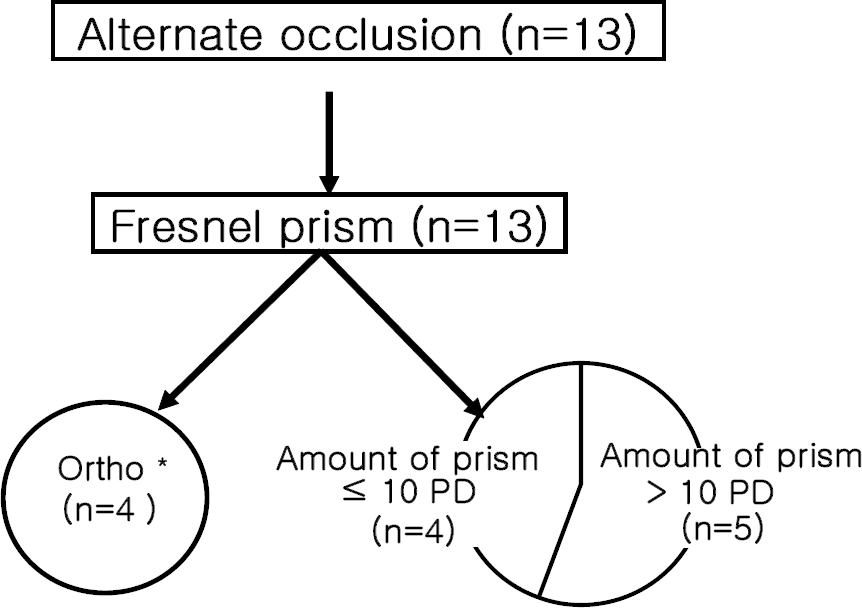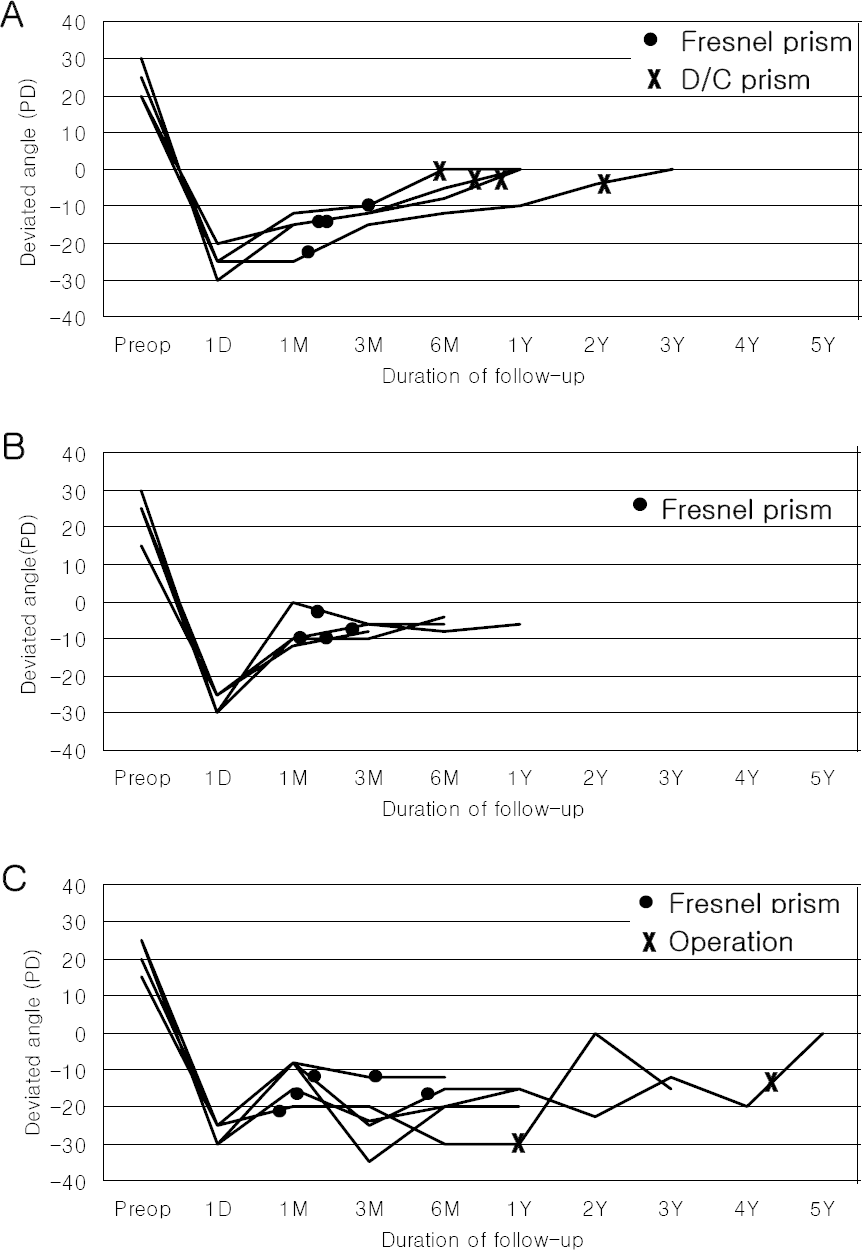Abstract
Purpose
To report the clinical course of severe consecutive esotropia (ET) with an esotropic angle at postoperative day 1 larger than the preoperative exotropia angle (XT).
Methods
Patients with ET angles at postoperative 1 day greater than their preoperative XT angles were included; the case of lost lateral rectus during surgery was excluded. Preoperative clinical characteristics and the course of postoperative alignment were analyzed, and binocularity was compared between the preoperative state and the postoperative state.
Results
The mean preoperative angle of XT of 13 patients was 23 prism diopters (PD) at distance and 27PD at near. Lateral incomitancy was observed in 9 patients. One day postoperatively, the mean angle of ET was 27PD at distance and 25PD at near, and alternate occlusion therapy was performed in all patients. However, the angle of ET was decreased 10PD or less in only 3 patients. All 13 patients were managed with Fresnel prisms, and 4 patients had orthotropia. Another 4 patients used glass prisms because they had ET of 8PD or less, and the remaining 5 patients still showed an ET with 12PD or more. Binocularity after surgery was worse than that before surgery in 64% of patients.
Conclusions
For patients with ET angles at postoperative 1 day greater than preoperative XT angles, the frequency of lateral incomitancy was high. Alternate occlusion and Fresnel prism treatment were needed in all patients. Recovery from orthotropia and the prognosis of binocularity were relatively poor.
Go to : 
References
1. Richard JM, Parks MM. Intermittent exotropia. Surgical results in different age groups. Ophthalmology. 1983; 90:1172–7.
2. Ruttum MS. Initial versus subsequent postoperative motor alignment in intermittent exotropia. J AAPOS. 1997; 1:88–91.

3. McNeer KW. Observations on the surgical overcorrection of childhood intermittent exotropia. Am Orthopt J. 1987; 37:135–50.

4. Weston B, Enzenauer RW, Kraft SP, Gayowsky GR. Stability of the postoperative alignment in adjustable-suture strabismus surgery. J Pediatr Ophthalmol Strabismus. 1991; 28:206–11.

5. Hur J, Won IG. Surgical results of 79 cases of intermittent exotropia in children. J Korean Ophthalmol Soc. 1990; 31:114–9.
6. Ko KH, Min BM. Factors related to surgical results of intermittent exotropia. J Korean Ophthalmol Soc. 1996; 37:179–84.
7. Wright KW. Practical aspects of the adjustable suture technique for strabismus surgery. Int Ophthalmol Clin. 1989; 29:10–5.

8. Souza-Dias C, Uesugui CF. Postoperative evolution of the planned initial overcorrection in intermittent exotropia: 61 cases. Binocul Vis Eye Muscle Surg Q. 1993; 8:141–8.
9. Choi MY. Surgical results in basic exotropia of moderate degree. J Korean Ophthalmol Soc. 2000; 41:764–70.
10. Pratt-Johnson JA, Barlow JM, Tillson G. Early surgery in intermittent exotropia. Am J Ophthalmol. 1977; 84:689–94.

12. Moore S. The prognostic value of lateral gaze measurement in intermittent exotropia. Am Orthopt J. 1969; 19:69–71.
13. Son AN, Park SC, Lee WR. Clinical study of consecutive esotropia. J Korean Ophthalmol Soc. 1990; 31:1328–34.
15. Beneish R, Flanders M. The role of stereopsis and early postoperative alignment in long-term surgical results of intermittent exotropia. Can J Ophthalmol. 1994; 29:119–24.
16. Paik HJ, Cho YA. Recession of the lateral recti in intermittent exotropia evaluation of the amount of immediate postoperative deviation. J Korean Ophthalmol Soc. 1990; 31:1445–50.
17. Park YH, Kim MM. Surgical results of intermittent exotropia. J Korean Ophthalmol soc. 1989; 30:969–74.
18. Raab EL, Parks MM. Recession of the lateral recti. Early and late postoperative alignments. Arch Ophthalmol. 1969; 82:203–8.
19. Kim JH, Hwang JM. Initial overcorrection of 20 Δ or more after surgery of exotropoia. J Korean Ophthalmol Soc. 2003; 44:121–7.
20. Kim HS, Suh YW, Kim SH, Cho YA. Consecutive esotropia in intermittent esotropia patients with immediate postoperative overcorrection more than 17 prism diopters. Korean J Ophthalmol. 2007; 21:155–8.

21. Wright KW. Color atlas of ophthalmic surgery: strabismus. Philadelphia: Lippincott;1991. p. 241–3.
22. Scott WE, Keech R, Mash AJ. The postoperative results and stability of exodeviations. Arch Ophthalmol. 1981; 99:1814–8.

23. Clarke WN, Noel LP. Surgical results in intermittent exotropia. Can J Ophthalmol. 1981; 16:66–9.
24. Lee SY, Lee YC. Relationship between motor alignment at postoperative day 1 and at year 1 after symmetric and asymmetric surgery in intermittent exotropia. Jpn J Ophthalmol. 2001; 45:167–71.

25. Lew H, Lee JB, Han SH, Park HS. Clinical evaluation on the consecutive esotropia after exotropia surgery. J Korean Ophthalmol Soc. 1999; 40:3482–90.
26. Park HS, Kim JB, Seo MS. . A study on the consecutive esotropia after intermittent exotropia surgery. J Korean Ophthalmol soc. 1994; 35:191–8.
27. Edelman PM, Brown MH. The stability of surgical results in patients with deep amblyopia. Am Orthopt J. 1977; 27:103–6.

28. von Noorden GK, Campos EC.Binocular vision and ocular motility. 6th ed. St. Louis: Mosby;2002:p. 345–7.
29. Keech RV, Stewart SA. The surgical overcorrection of intermittent exotropia. J Pediatr Ophthalmol Strabismus. 1990; 27:218–20.

30. Dunlap EA. Overcorrection in exotropia surgery. St. Louis: The C.V. Mosby Co.;1971. p. 183.
31. Gill MK, Drummond GT. Indications and outcomes of strabismus repair in visually mature patients. Can J Ophthalmol. 1997; 32:436–40.
32. You IC, Yoon KC, Park YG. Assessment of esotropia more than 10PD after surgery of intermittent exotropia. J Korean Ophthalmol Soc. 2003; 44:2278–84.
33. Lee JM, Shin SY. Recovery pattern of overcorrection after intermittent exotropia surgery. J Korean Ophthalmol Soc. 2005; 46:821–6.
34. Min BM, Lee SB. Consecutive esotropia following surgery for intermittent exotropia. J Korean Ophthalmol Soc. 1999; 40:3491–6.
35. von Noorden GK.von Noorden GK, editor. Esodeviation. Binocular vision and ocular motility. 5th ed. St. Louis: Mosby;1996. p. chap. 14.
37. Kim YH, Choi MY. The effect of Fresnel prism treatment in consecutive esotropia. J Korean Ophthalmol Soc. 2006; 47:1623–9.
Go to : 
 | Figure 1.This diagram shows treatment process and their result in the severe consecutive esotropia after surgery for intermittent exotropia.* Orthotropia without Fresnel prism. |
 | Figure 2.Change of the angle of deviation during the follow-up after surgery for intermittent exotropia. (A) Orthotropia without treatment at the last follow-up. (B) Consecutive esotropia ≤10PD at the last follow-up. (C) Consecutive esotropia > 10PD at the last follow-up.* Prism diopters; † Preoperation; ‡ Day; § Month; п Year. |
 | Figure 3.Comparison of stereopsis (A) and fusion (B) in between preoperation and postoperation.* Seconds of arc; † Gross stereopsis; ‡ No stereopsis; § Fusion at far and near; ∏ Fusion at near; # No fusion. |
Table 1.
Preoperatvie characteristics
| No. A | Age (yr)/Sex |
XT* (PD†) |
) Associated strabismus | Amount of lateral incomitancy (PD) | Oth |
SE‡ |
Type of surgery | |
|---|---|---|---|---|---|---|---|---|
| Far/Near | Right/Left | |||||||
| 1 | 8.3/M | 25/25 | Hyper§ (10PD) | 5 | Amblyopia, Congenital cataract | -0.5/-2 | R&R∏ | |
| 2 | 12.0/F | 20/25 | 0 | -2.25/-3 | BLR# | |||
| 3 | 7.5/F | 20/28 | 5 | -1/-1 | R&R | |||
| 4 | 9.5/F | 30/40 | 10 | -4/-4 | R&R | |||
| 5 | 9.0/M | 15/23 | 0 | -0.75/-1 | R&R | |||
| 6 | 5.0/F | 25/30 | 5 | 1/0.5 | R&R | |||
| 7 | 14.0/M | 30/30 | Hyper (10PD) | 10 | -3/-2.25 | R&R | ||
| 8 | 8.7/F | 25/30 | 5 | -2.75/-2.75 | BLR | |||
| 9 | 6.3/F | 25/28 | IOOA** | 5 | 0.25/0.25 | BLR, Inferior oblique myectomy | ||
| 10 | 9.7/M | 25/25 | Hyper (4PD) | 5 | -1.25/-1.75 | R&R | ||
| 11 | 6.3/F | 20/25 | 0 | -3.25/-3 | BLR | |||
| 12 | 8.0/F | 15/20 | 3 | -3/-3 | ULR†† | |||
| 13 | 6.0/F | 25/25 | Hyper (10PD) | 0 | Amblyopia, Macular toxoplasmosis | 0/0 | R&R | |
Table 2.
Duration and types of treatment in the patients with consecutive esotropia
| No. A |
Duration of treatment (mo) |
Amount of FP A | Angle of esodeviation at ‡ | Type of surgery‡ | ||
|---|---|---|---|---|---|---|
| Alternate occlusion | FP* | (PD†) | last visit (PD) | |||
| 1 | 1.8 | 24.8 | 20 | 0 | ||
| 2 | 2.0 | 17.0 | 8 | 0 | ||
| 3 | 3.9 | 3.7 | 20 | 0 | ||
| 4 | 2.0 | 11.0 | 6 | 0 | ||
| 5 | 1.8 | 0.2 | 8 | 8 | ||
| 6 | 3.1 | 2.6 | 8 | 8 | ||
| 7 | 2.3 | 7.9 | 10 | 8 | ||
| 8 | 2.2 | 14.8 | 8 | 4 | ||
| 9 | 3.9 | 3.0 | 12 | 12 | ||
| 10 | 1.2 | 11.0 | 16 | 20 | ||
| 11 | 1.4 | 14.0 | 12 | 30 | ||
| 12 | 5.5 | 50.4 | 20 | 30 | MR rec§ | |
| 13 | 1.0 | 10.9 | 24 | 30 | LR adv§ | |




 PDF
PDF ePub
ePub Citation
Citation Print
Print


 XML Download
XML Download